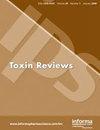Inhibition of phospholipase A2 from Naja haje and Naja nigricollis venoms by active fraction of Moringa oleifera leaves: in vitro and in silico methods
IF 2.4
4区 医学
Q2 TOXICOLOGY
引用次数: 0
Abstract
Abstract Phospholipases are one of the principal toxic enzymes in snake venoms inducing a wide variety of pharmacological effects after envenomation. Natural inhibitors from plants are known to inhibit the toxic enzyme activities of snake venoms. In this study, ethanol crude extract of M. oleifera leaves was partitioned using n-hexane and ethyl acetate after which fractionation was done using column and thin layer chromatography. Subsequently, the inhibitory activities of the crude extract and sub-fractions of M. oleifera were investigated against phospholipases A2 isolated from Naja haje and Naja nigricollis venoms using in vitro and in-silico approaches while EchiTab-PLUS polyvalent antivenom was used as the standard drug. The molecular weight of isolated N. haje phospholipase A2 (NH-PL) and N. nigricollis phospholipase A2 (NN-PL) were 24.11 and 35.22 kDa respectively. NH-PL enzyme had a specific activity of 2.70 μM/min/mg substrate while NN-PL activity was 2.10 μM/min/mg substrate. The Km of NH-PL was 0.330 μM with Vmax of 0.085 μM/mL min while NN-PL had Vmax of 0.198 μM/mL.min and Km of 0.670 μM. M. oleifera n-hexane sub-fraction 5 (MOLH5) exhibited a total inhibition of NN-PL and NH-PL enzyme activities at all concentrations used. Molecular docking of the phytoconstituents of MOLH5 against the catalytic site of phospholipase A2 revealed 2-Hydrazino-8-hydroxy-4-phenylquinoline as the lead compound and a potential drug candidate with a docking score of −6.789 kcal/mol. Findings indicated that MOLH5 possesses phospholipase A2 natural inhibitors that could be explored as a therapy for snake envenoming.辣木叶活性组分对黑醋和黑醋毒磷脂酶A2的抑制作用:体外和电子方法
磷脂酶是蛇毒中主要的毒性酶之一,在蛇毒中毒后可诱导多种药理作用。已知来自植物的天然抑制剂可以抑制蛇毒的毒性酶活性。本研究采用正己烷和乙酸乙酯对油橄榄叶乙醇粗提物进行分离,然后采用柱层析和薄层析进行分离。随后,以EchiTab-PLUS多价抗蛇毒血清为标准药,采用体外和芯片法研究了油橄榄粗提物和亚组分对日本Naja haje和Naja nigricollis毒液中磷脂酶A2的抑制活性。分离得到的哈氏黑僵菌磷脂酶A2 (NH-PL)和黑僵菌磷脂酶A2 (NN-PL)分子量分别为24.11和35.22 kDa。NH-PL酶的比活性为2.70 μM/min/mg底物,而NN-PL酶的比活性为2.10 μM/min/mg底物。NH-PL的Km为0.330 μM, Vmax为0.085 μM/mL min,而NN-PL的Vmax为0.198 μM/mL。min和Km为0.670 μM。油橄榄正己烷亚组分5 (MOLH5)在所有浓度下均表现出对NN-PL和NH-PL酶活性的完全抑制作用。将MOLH5的植物成分与磷脂酶A2的催化位点进行分子对接,发现2-肼基-8-羟基-4-苯基喹啉为先导化合物,对接得分为−6.789 kcal/mol。结果表明,MOLH5具有磷脂酶A2天然抑制剂,可作为蛇毒的治疗手段。
本文章由计算机程序翻译,如有差异,请以英文原文为准。
求助全文
约1分钟内获得全文
求助全文
来源期刊

Toxin Reviews
医学-毒理学
CiteScore
6.80
自引率
0.00%
发文量
36
审稿时长
>12 weeks
期刊介绍:
Toxin Reviews provides an international forum for publishing state-of-the-art reviews and guest-edited single topic special issues covering the multidisciplinary research in the area of toxins derived from animals, plants and microorganisms. Our aim is to publish reviews that are of broad interest and importance to the toxinology as well as other life science communities. Toxin Reviews aims to encourage scientists to highlight the contribution of toxins as research tools in deciphering molecular and cellular mechanisms, and as prototypes of therapeutic agents. Reviews should emphasize the role of toxins in enhancing our fundamental understanding of life sciences, protein chemistry, structural biology, pharmacology, clinical toxinology and evolution. Prominence will be given to reviews that propose new ideas or approaches and further the knowledge of toxinology.
 求助内容:
求助内容: 应助结果提醒方式:
应助结果提醒方式:


